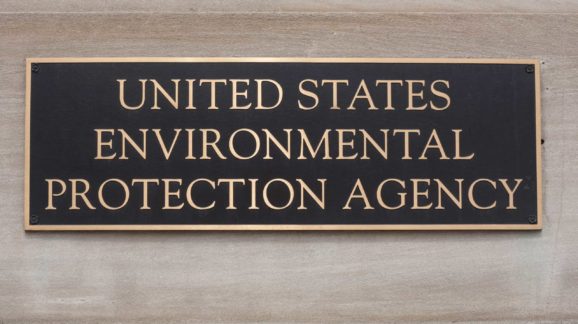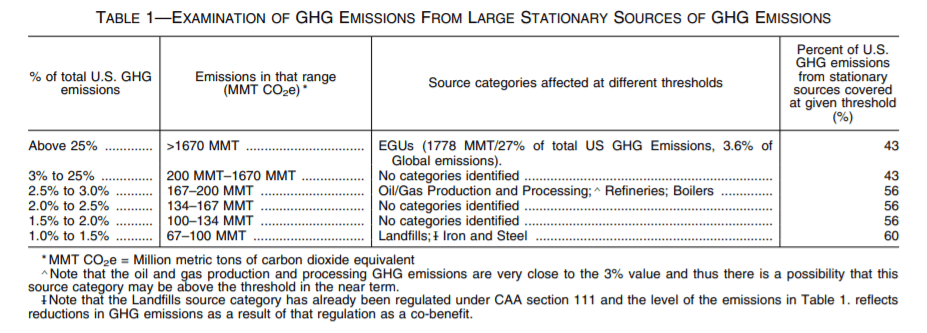Trump EPA’s January Surprise: Timely New Check on Regulatory Excess

Photo Credit: Getty
The Environmental Protection Agency (EPA) on January 13 published its long-awaited final rule on New Source Performance Standards (NSPS) for greenhouse gas (GHG) emissions from new fossil fuel power plants. This was the Trump administration EPA’s last major regulatory action.
New Year’s Surprise
To the surprise of many observers (myself included), the new rule does not revise the standards adopted by the Obama EPA’s October 2015 final rule, nor does it revise the best system of emission reduction (BSER) analysis on which those standards are based.
The 2015 rule determined that “partial” carbon capture and storage (CCS) is the “adequately demonstrated” BSER for new coal power plants. Based on that assessment, it established an NSPS of 1,400 pounds (lbs.) of carbon dioxide (CO2) per megawatt hour (MWh) (80 FR 64512).
In contrast, the Trump EPA’s December 2018 draft rule argued that partial CCS is too costly and geographically limited to qualify as the BSER. It proposed to determine that efficient generation technologies combined with best practices is the adequately demonstrated BSER. Based on that assessment, it proposed the following performance standards: 1,900 lbs. CO2/MWh for new, large coal power plants; 2,000 lbs. CO2/MWh for new, small coal power plants; and 2,200 lbs. CO2/MWh for new coal refuse-fired power plants (83 FR 65427).
The Trump EPA’s final rule, published on January 13, devotes only one sentence to those issues—to announce that it is not going to address them:
Any action regarding the proposal to revise the standards of performance, including the underlying determinations of the BSER, for new, reconstructed, and modified coal-fired electric generating units, including certain technical issues, is beyond the scope of this final rule and comments received on the 2018 Proposal will be addressed in a separate future action [86 FR 2544].
Clarification of the Statute’s Application to GHGs
What then does the final rule do? It clarifies how the EPA’s statutory authority to establish new source performance standards, Section 111(b) of the Clean Air Act applies to greenhouse gases. The endangerment test in Section 111(b) is unlike that in the Section 108 national ambient air quality standards program or the Section 202 motor vehicle emissions standards program. Those programs require regulation if the EPA determines that an air pollutant “causes or contributes to” dangerous air pollution. The Section 111(b) endangerment test includes, in addition, a requirement that the EPA make a “significant contribution finding” (SCF). The fact that a source category “contributes” to dangerous air pollution is not enough to trigger regulation. The category must also contribute “significantly.”
So, instead of finalizing a BSER or CO2 performance standards for new coal power plants, the final rule provides a framework for assessing whether any industrial source category “contributes significantly” to “dangerous air pollution” due to its GHG emissions.
That was quite unexpected. Nearly all the issues on which the draft rule requested comment pertained to the proposed BSER and associated standards. It did not request comment on how to distinguish between significant and insignificant categories of GHG emission sources. However, that issue arose naturally from the Trump EPA’s reaffirmation of the Obama EPA’s conclusion that coal power plant GHG emissions “contribute significantly to dangerous air pollution.”
Rationale for Clarification
Section 111(b) clearly implies that the EPA is to distinguish between a contribution and a significant contribution to dangerous pollution. The statute does not provide any criteria to inform that judgment. That has not been source of perplexity and strife because, for decades, NSPS exclusively targeted industrial sources of criteria and toxic air pollutants. If uncontrolled, even relatively small and isolated sources of such pollutants can have significant “local, near-term impacts” on public health (86 FR 2551).
The situation is quite different for GHG sources. The local, near-term impacts of CO2 emissions from even the largest sources are negligible. GHG-related health impacts are indirect, mostly remote in time, and attributed to “cumulative global loading” from all sources worldwide since the dawn of the industrial age (86 FR 2551). The contribution of a source category may be smaller than the proverbial drop in the bucket. The meaning of “significant” ceases to be intuitively obvious.
Accordingly, the final rule argues, “some type of (reasonably explained and intelligible) standard and/or established set of criteria that can be consistently applied is necessary.” Such criteria can “help ensure that EPA’s decision-making is well-reasoned and consistent” (86 FR 2547).
Note, though, the new final rule does not challenge but rather reaffirms the 2015 rule’s significant contribution finding for power plants (86 FR 2549). When the EPA made that finding, power plants accounted for “almost one-third” of all U.S. GHG emissions and almost “three times as much” CO2 as “the next ten source categories combined” (80 FR 64530). If that contribution is not “significant,” none is.
The EPA concludes that when assessing the significance of a source category’s GHG emissions, “the quantity of emissions should be the primary criterion that the EPA should evaluate” (86 FR 2551). The rule considers and rejects a tonnage threshold. It explains that, as U.S. CO2 emissions decline, some source categories that were once above a tonnage threshold would fall below it. Potentially, no source categories would be regulated even if all “collectively … pose a danger to public health and welfare” (86 FR 2554).
The EPA consequently selects a relative contribution threshold. Specifically, the agency “is introducing a threshold of 3 percent of U.S. GHG emissions to evaluate a source category’s emissions to determine significance for purposes of CAA Section 111(b).” By the same token, the EPA is determining that source categories contributing 3 percent or less of U.S. GHG emissions “are necessarily insignificant without consideration of any other factors” (86 FR 2552-2553).
Such other factors, which the EPA calls “secondary criteria,” include the relative contribution of the U.S. source category compared to worldwide emissions from similar sources, whether a source category’s GHG emissions are increasing or declining, and whether regulation of “trade exposed” industries would induce production shifts increasing emissions in other parts of the world (86 FR 2555).
Timely Check on Regulatory Excess
In developing its framework, the EPA found “two natural breakpoints” or gaps between groups of source categories. The first is between electric generating units (EGUs), which contribute more than 25 percent of U.S. GHG emissions, and all other categories. Indeed, EGUs are the only source category contributing 3 percent or more of U.S GHG emissions. Three categories—oil and gas production, petroleum refining, and industrial boilers—each emits 2.5 percent or more but still less than 3 percent. The second gap is between those categories and all the others. Every other category emits less than 1.5 percent of U.S. GHG emissions (86 FR 2552).

The NSPS program currently regulates 141 source categories of criteria and toxic air pollutant emissions. Such sources include medical waste incinerators, municipal waste combustors, steel-making furnaces, fertilizer production plants, paper mills, glass manufacturing plants, beverage-can coating plants, to mention just a few. Under the EPA’s final rule, all categories except power plants are exempt from regulation for GHG emissions.
Climate campaigners may object that no GHG emission source is too small to ignore. However, that is a political judgment and legally unsupportable.
Fossil-fuel EGUs account for 43 percent of industrial category GHG emissions (86 FR 2552), yet even total elimination of that category—a power well beyond the reach of Section 111(b) regulation—would hypothetically avert only 0.049°C of global warming by 2100. Eliminating the next largest source category—oil and gas processing and production—“would only generate an additional hypothetical global mean temperature reduction of 0.01°C and even smaller source categories correspondingly contribute less to global temperature” (86 FR 2553).
With the Biden administration expected to pursue aggressive Clean Air Act regulation to decarbonize the economy, the Trump EPA’s last regulatory action is both prudent and timely. There are no adequately demonstrated technologies for decarbonizing beverage-can coating plants, etc. The closest facsimile would be energy and process efficiency enhancements that competitive markets continually drive new industrial facilities to incorporate anyway.
Congress did not authorize the EPA to be America’s energy-efficiency nanny. Micromanaging industrial activities to make minor GHG emission reductions in climatologically insignificant sources would waste agency resources while imposing pointless paperwork burdens on the private sector.
Whether the rule will help constrain the Biden EPA’s regulatory ambitions is, of course, unknown at this point. At a minimum, though, the rule will compel the EPA, in future NSPS rulemakings targeting GHG emissions, to propose and defend alternative criteria for determining which source categories “contribute significantly” and which do not.